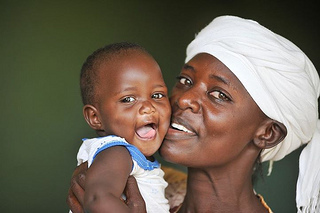Clive, a teenager in the UK who was born with HIV, told The Guardian last year that he lives in denial of his condition. Like many children who grow up in the shadow of the disease, he is keenly aware of the social and even moral stigma surrounding the virus, and these feelings affect his treatment. “It angers me that HIV is considered such a dirty thing by so many people,” Clive told The Guardian. “It’s partly because I have to live this life of shame and secrecy that I find it so hard to take my meds.”
Though HIV is often described as a sexually transmitted disease, many victims are children who acquire the virus before, during, or shortly after birth. Nearly 10% of the 34 million people living with HIV worldwide are under age 15, and 210,000 children die of AIDS each year.1
Since the introduction of antiretroviral (ARV) medicines, quality and length of life have increased for those living with HIV. Yet this incredible advance also brings challenges. With longer and healthier lives, women of reproductive age living with HIV have a greater chance of giving birth while infected. The good news, however, is that mother-to-child transmission of HIV is preventable, and organizations such as the United Nations and the World Health Organization are working aggressively to end it.
Over the 30 years since the HIV epidemic hit, there have been both dramatic advancements and ongoing challenges in HIV prevention efforts.(a) While approaches to prevention differ depending on population, resources, and risk, there are certain instances where transmission is almost entirely preventable. One important opportunity lies in preventing the virus from passing to a child during pregnancy and childbirth. As of 2008, mother-to-child transmission (MTCT) accounted for approximately 90% of HIV infections in children.2 Transmission can occur before, during, or after delivery, but it is most frequent during late pregnancy and delivery.3
The burden of MTCT of HIV, sometimes referred to as vertical transmission, is severe, particularly in low- and middle-income countries,(b) where MTCT accounted for an estimated 430,000 new HIV infections in children in 2009.4 This burden is greatest in places with high HIV prevalence, lack of access to medical care during pregnancy, and lack of services that provide information, education, and proper testing and treatment to new mothers.
Fortunately, the risk of MTCT can be reduced to around 1% with the appropriate treatment.5 Prevention efforts may include antiretroviral treatment for the mother during pregnancy and delivery, an elective c-section, refraining from breastfeeding, and administering ARV drugs to the newborn.5 It is estimated that since 1995, more than 350,000 children have avoided HIV infection due to ARVs provided to pregnant women living with HIV.4 However, in 2011, only 30% of eligible pregnant women in low- and middle-income countries who needed ARV therapy received it, compared to 54% of all eligible adults in these countries.6 This gap suggests that treatment may not be reaching those who need it most. Treating a mother living with HIV has a double benefit: it will likely benefit the mother while also preventing a child from becoming infected.(c)
Given such a significant opportunity for vast reduction in HIV transmission to children, the United Nations and other global health organizations have launched a sweeping effort to end new infections among children by 2015.7 In 2012, the World Health Organization (WHO) developed a clear framework for reducing mother-to-child transmission by 90% by 2015, a level low enough that MTCT would no longer be considered a major health problem.4 This goal is aligned with other global health initiatives that aim to reduce new infections by increasing access to family planning services for women living with HIV; providing HIV testing, counseling, and ARVs in a timely manner to pregnant women who need them; and providing treatment, care and support for families living with HIV.7
Education concerning HIV and MTCT and access to care and treatment for at-risk populations is crucial in the global fight to prevent new HIV infections, particularly in children. Women without access to reproductive health services may not receive HIV testing, an increasingly essential part of antenatal services across the globe. These women may never know that they could transmit the HIV virus to their children. Increasing access to services and education about HIV testing and prevention of mother-to-child transmission could not only save lives but also save the costs of lifetime HIV treatment in areas with limited resources.
Is the goal of ending child HIV infections achievable? While ambitious, the ability to reduce the risk of MTCT HIV infections is scientifically feasible.(d) However, this initiative will not be successful without support and prioritization from multiple levels, from governments down to local communities and health facilities. Improving health infrastructure, as well as combating stigma and discrimination against children and adults living with HIV, is crucial. While complex and multifaceted, the opportunity to end child HIV infections, save lives, and prevent illness and disease for many is truly worth the effort.
Endnotes
- The Foundation for AIDS Research (2013) “Statistics: Worldwide.”
- A. Coutsoudis, L. Kwaan, and M. Thomson (2010) “Prevention of vertical transmission of HIV-1 in resource-limited settings,” Expert review of anti-infective therapy,8(10): 1163-1175.
- Marie-Louise Newell (1998) “Mechanisms and timing of mother-to-child transmission of HIV-1,” AIDS, 12: 831-837.
- World Health Organization (2012) “Global Monitoring Framework and Strategy for the Global Plan towards the elimination of new HIV infections among children by 2015 and keeping mothers alive (EMTCT).”
- Claire Thorne and Marie-Louise Newell (2007) “HIV,”Seminars in fetal & neonatal medicine, 12(3): 174-181.
- World Health Organization, UNAIDS, and UNICEF (2011) “Global HIV/AIDS Response: Epidemic update and health sector progress towards Universal Access.” Geneva: World Health Organization.
- Joint United Nations Programme on HIV/AIDS (UNAIDS) (2012) “Report on the Global AIDS Epidemic.”
Sidenotes
- (a) About 2.5 million people worldwide contracted HIV in 2011 – 700,000 fewer than in 2001.
- (b) The prevalence of HIV is highest in sub-Saharan Africa, which is home totwo-thirds of all people living with the virus worldwide and where nearly 1 in 20 adults are infected.
- (c) Women constitute about half the people living with HIV worldwide and 60% of those in sub-Saharan Africa. TheWorld Health Organization claims that gender inequality affects HIV transmission through gender norms that encourage men to have multiple sexual partners, disempowerment of women to access care and make sexual decisions, and violence toward women including rape and emotional abuse.
- (d) Research by UNAIDS on high-risk countries determined that the MTCT rate – the likelihood that an HIV-positive mother will transmit the disease to her child – varies significantly depending on access to antiretroviral therapy. In Botswana, where over 95% of at-risk mothers receive treatment, there is a 3% transmission rate, while in Angola, just 16% of mothers receive treatment and the transmission rate is 34%.





